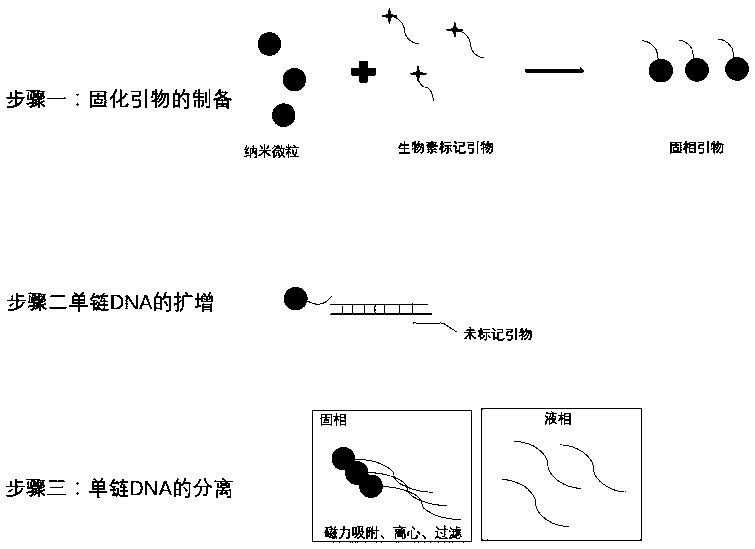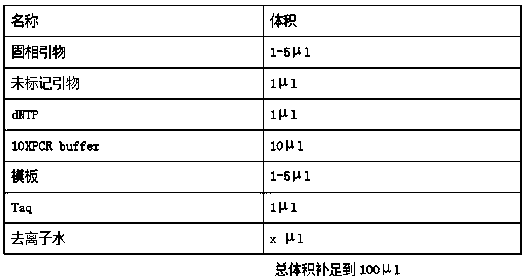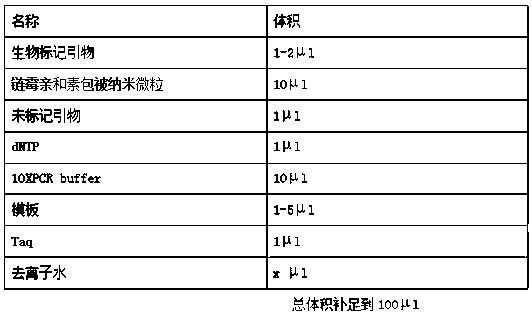Nanoparticle single chain DNA amplification method based on streptavidin coating
A streptavidin and nanoparticle technology, applied in DNA preparation, recombinant DNA technology, etc., can solve the problems of cumbersome operation and long separation operation time, and achieve the effects of improving economy, efficient preparation, and simple and efficient action.
- Summary
- Abstract
- Description
- Claims
- Application Information
AI Technical Summary
Problems solved by technology
Method used
Image
Examples
Embodiment 1
[0050] 1. Preparation of solid-phase primers;
[0051] Take 5 μl of 100 μM biotin-labeled primer and 100 μl streptavidin-coated magnetic nanoparticles and incubate at room temperature for 30 minutes, remove the liquid phase under the action of a magnetic separator, rinse with deionized water, and then use magnetic separation again to remove the rinse solution. Then add 5 μl deionized water to suspend for later use.
[0052] 1. Single-stranded DNA amplification system:
[0053]
[0054] Single-stranded DNA amplification reaction conditions:
[0055] According to the Tm value of the primers, the single-stranded DNA amplification reaction conditions were set according to the conventional conditions of the PCR reaction.
[0056] 3. Separation of single-stranded DNA:
[0057] After the amplification reaction is completed, use a magnetic separator to separate the solid and liquid of the reaction system, and absorb the liquid phase for storage. After adding an appropriate amo...
Embodiment 2
[0059] 1. Preparation of solid-phase primers;
[0060] Take 5 μl of 100 μM biotin-labeled primers and 100 μl of streptavidin-coated non-magnetic nanoparticles and incubate at room temperature for 30 minutes, centrifuge to remove the liquid phase, rinse with deionized water, and centrifuge again to remove the rinse solution . Then add 5 μl deionized water to suspend for later use.
[0061] 2. Single-stranded DNA amplification system:
[0062]
[0063] Single-stranded DNA amplification reaction conditions:
[0064] According to the Tm value of the primers, the single-stranded DNA amplification reaction conditions were set according to the conventional conditions of the PCR reaction.
[0065] 3. Separation of single-stranded DNA:
[0066] After the amplification reaction is completed, use a centrifuge to separate the solid and liquid of the reaction system, and absorb the liquid phase for storage. After adding an appropriate amount of deionized water to rinse the nanopart...
Embodiment 3
[0068] 1. Preparation of solid-phase primers;
[0069] Take 5 μl of 100 μM biotin-labeled primer and 100 μl streptavidin-coated magnetic nanoparticles and incubate at room temperature for 30 minutes, remove the liquid phase under the action of a magnetic separator, rinse with deionized water, and then use magnetic separation again to remove the rinse solution. Then add 5 μl deionized water to suspend for later use.
[0070] 2. Single-stranded DNA amplification system:
[0071]
[0072] Single-stranded DNA amplification reaction conditions:
[0073] According to the Tm value of the primers, the single-stranded DNA amplification reaction conditions were set according to the conventional conditions of the PCR reaction.
[0074] 3. Separation of single-stranded DNA:
[0075] After the amplification reaction is completed, use a magnetic separator to separate the solid and liquid of the reaction system, and absorb the liquid phase for storage. After adding an appropriate amo...
PUM
| Property | Measurement | Unit |
|---|---|---|
| diameter | aaaaa | aaaaa |
Abstract
Description
Claims
Application Information
 Login to View More
Login to View More - R&D
- Intellectual Property
- Life Sciences
- Materials
- Tech Scout
- Unparalleled Data Quality
- Higher Quality Content
- 60% Fewer Hallucinations
Browse by: Latest US Patents, China's latest patents, Technical Efficacy Thesaurus, Application Domain, Technology Topic, Popular Technical Reports.
© 2025 PatSnap. All rights reserved.Legal|Privacy policy|Modern Slavery Act Transparency Statement|Sitemap|About US| Contact US: help@patsnap.com



